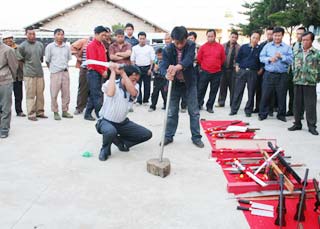------Program code: DO-080828-01354 (what's this?)
Source: CCTV.com
08-28-2008 09:40
Knives have always played an important role in traditional Chinese culture. Originally used for hunting and work, they later became weapons used in battle. The knife is one of the oldest weapons in China. Heroes were often depicted as carrying knives, whether it was the real-life Wang Zhengyi or the legendary Li Xunhuan.
 |
There are numerous places across China’s vast territory that are associated with knives. In Longchuan County on the Yunnan border live a group of people who continue to make one of the most famous knives in China – the Husa knife.
In this frontier Yunnan village lives a man named Xiang Laosai. He is often referred to as the “King of the Husa Knife”. The title derives from a competition first held hundreds of years ago. Today, he proudly carves it onto his knives.
 |
Longchuan County is the largest population centre of a people known as the Achang. It’s a beautiful area, sometimes called the Buddha’s garden. The story goes that the Buddha wanted to build a garden in the human world, but could not find anywhere pleasant enough. It was only on his way back to heaven that he spotted what he was looking for – a charming plateau area. The place is today called Husa, and it lies at the heart of the ancient Ailao region.
Husa is a small place. According to historical records, in the 14th century, during the reign of Hongwu, first emperor of the Ming Dynasty, General Mu Ying was sent to subdue the western regions. He deployed a group of soldiers to cultivate the Husa area. The soldiers taught the local Achang people to forge knives. For the next 600 years, the unique skills were handed down. Still today, at 6 or 7 o’clock in the morning, the villages start echoing to the sound of metal being hammered.
There are literally hundreds of households in Husa where the knives are made. Xiang Laosai, with his fame as the king of the Husa knife, attracts more buyers than most. His original workshop eventually became too crowded. Even though the workshop was an old family treasure, he decided to build a new, bigger one. When finished, it will be big enough for dozens of people to work together.
The Husa knife is produced by the Achang people, based on techniques developed by Han people. The skills of making it are unique. They matured in the Ming and Qing Dynasties, and flourished under the Republic of China. Over the centuries, the Husa Knife has enjoyed periods of prosperity and decline, rather like human society. In the modern world of machine production, the hand-made knives are gaining in popularity. The delicately-forged knives embody the skills and aesthetic appreciation of their makers.
King of the Husa knife is only a title; the knives that earn the title must be outstanding. So why, among the hundreds of knife-makers, was Xiang Laosai honoured?
Making a Husa Knife involves more than a dozen processes. The quality depends on one step in particular – the toughening, when the proper combination of hardness and flexibility is achieved through heating. An old adage for evaluating a blade goes: soft enough to encircle a finger, sharp enough to break a hair blown onto it, and hard enough to cut through iron.
However, the new workshop project isn’t proceeding as smoothly as anticipated. Today was supposed to be the day when the beams were put in place. Xiang Laosai had made all the arrangements. But an unexpected shower in the morning ruins his plans.
Xiang Laosai never went to school. Instead he became a knife-maker at 14, having learned from his father. He worked hard, and was always willing to test new ideas. He eventually gained recognition as a master craftsman. When he was 27, he established his own workshop, where he made a number of improvements to the techniques taught him by his father. He followed the traditions, but added some of his own ideas. His aim was always to achieve two things; increase the market demand and improve quality. To forge a knife capable of cutting through metal was not easy. Xiang Laosai focused on the toughening and developed several techniques of his own. Today, his well-designed and extremely sharp knives are very popular among those who love knives.
